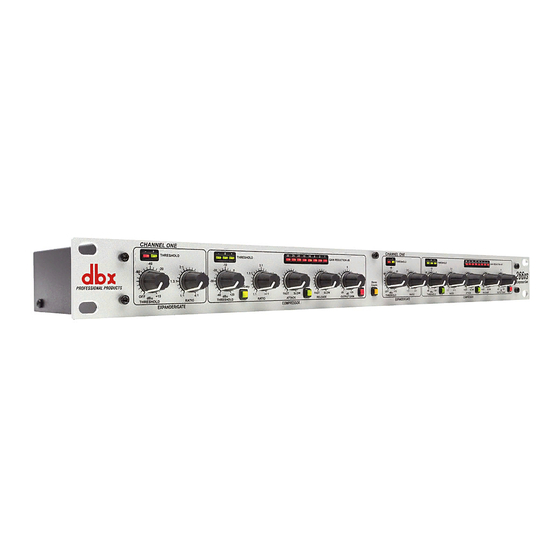dbx Dynamics Duo Manuel de révision - Page 4
Parcourez en ligne ou téléchargez le pdf Manuel de révision pour {nom_de_la_catégorie} dbx Dynamics Duo. dbx Dynamics Duo 7 pages.

Detection and the Dynamics Duo
Other processors use averaging circuits for level detection, created by simple resistor-
capacitor (RC) filters which may approximate average power with some waveforms, but in
general will not coincide with the way the human ear and brain interpret sound. This is
because there is not a one-to-one correspondence between the average amplitude of a
waveform and the average power of that same waveform, resulting in a mismatch between
the detector's calculated signal level and your ear's perceived level. It's as if the averaging
detector is looking at the signal world through "fun house" mirror lenses.
A related method that has gained some popularity of late, due mainly to the availability
of these particular detector chips to the general public, is the "log average" method. But,
again, using averaging techniques, these logarithmic detectors exhibit the same error in
calculating signal level as illustrated above. Given these explanations, perhaps we have shed
some light on reasons why most processors work great only in certain situations with
certain types of signals.
Obviously, this is not the dbx way. Our processors use True RMS Level Detection for
signal sensing to most closely emulate human hearing response. Without going into a
detailed technical explanation, the mathematical concept of RMS (Root Mean Square)
describes an effective value of voltage or current that results in average power.This effective
value is called RMS because we take the square root of the mean of the squared values.
Disregarding the technical mumbo jumbo, just remember that the RMS value inherently
corresponds to the average power of the signal, as does the response of the human ear.With
sophisticated chips developed at dbx, utilizing patented integrated circuit designs to
calculate the RMS value of the signal, we are able to create unrivaled dynamics processors
with natural sound with the most listenable results over the widest range of signals.Those
who have used dbx processors know this to be true.
4. Duo Dynamics
What about stereo dynamics processing? Is there a special way required to link two
channels of compressors for processing a stereo signal, or do we just run each channel
through its own independent compressor? Those familiar with compressors know that for
processing stereo signals, each channel must react identically--that is, their VCA's must be
¨
Detection and the Dynamics Duo - November 1998
Page 3
